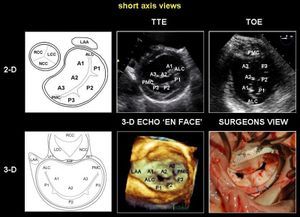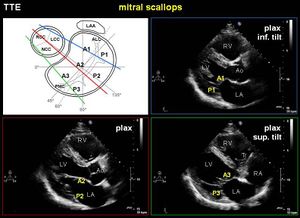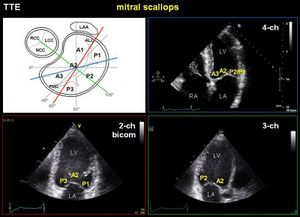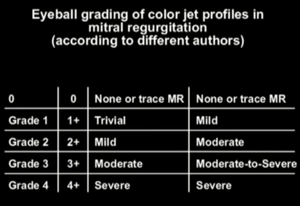We need you! Join our contributor community and become a WikEM editor through our open and transparent promotion process.
Mitral regurgitation
From WikEM
Contents
Background
- Annual incidence of degenerative Mitral Valve (MV) disease ~3% in industrialized countries causing MR[1]
- Other etiologies of MR:
- Cardiac ischemia
- Endocarditis
- Rheumatic disease
- SLE, scleroderma, amyloidosis, sarcoidosis
- Connective tissue disease (myxomatous degeneration, Marfan, Ehlers-Danlos)
- HOCM
- Dilated cardiomyopathy
- Mitral valve prolapse
- Congenital disorders
- Criteria for MV repair[2]:
- Development of NYHA class II symptoms
- Deterioration in LV function
- LV end systolic diameter < 4.5 cm with EF > 60% to protect LV function[3]
- However, recent evidence suggests best outcomes of MV repair are in asymptomatic or minimally symptomatic patients selected for surgery soon after echo dx[4]
Clinical Features
- Heart failure symptoms
- Atrial dilatation and atrial fibrillation
- Pulmonary hypertension
- Ischemic mitral incompetency, following myocardial infarction or LV aneurysm
- Most common mechanism of MR in developed countries
- Dysfunction of ventricular wall leads to papillary muscle dysfunction
- Posterior papillary muscle and supporting ventricular wall most commonly affected
Differential Diagnosis
Valvular Emergencies
- Mitral stenosis
- Mitral regurgitation
- Aortic stenosis
- Aortic regurgitation
Evaluation
- Clinical history and exam
- Most common cause is papillary / chordae rupture after MI in first week[5]
- Myocardial infarction, endocarditis, trauma
- Dyspnea, tachycardia, pulmonary edema
- Suspect if new-onset pulmonary edema, alongside normal heart size
- Cardiogenic shock
- S4, apical systolic murmur
- Clinical evaluation with auscultation may underestimate MR severity[6]
- Echo grading
- Traditional grading is different from ischemic MR grading
- Eyeball grading of color jet from 1+ to 4+, set to color gain that minimizes background noise
- Color jet area in atrium during maximal MR jet, obtain both PSL and apial 4 chamber, at Nyquist limit scale set of 60 cm/s
- Traditional grading is different from ischemic MR grading
- Ischemic MR grading based on lesion severity of papillary muscle
- Factors that increase MR grading severity
- Hypertension
- Concomitant aortic stenosis
- Mitral valve anatomy and scalloping much better appreciated in TEE over TTE
Management[7]
- Consult Cardiology and/or CT Surgery
- Supportive measures until definitive surgery
- Appropriate treatment if myocardial infarction to include cath or thrombolysis
- Pulmonary edema
- Oxygen
- Nitrates and diuresis may improve filling pressures and treat edema
- Early intubation for impending respiratory failure
- Decrease afterload
- Nitroprusside can be considered in normotensive patients to increase cardiac output and decrease MR
- Intra aortic balloon pump may decrease afterload, increase forward cardiac output and reduce regurgitation
- Inotropes
- Dobutamine pressor of choice as alpha agonism and increased afterload minimal compared to beta agonism[8]
- Do not alleviate tachycardia with beta-blockers as mild to moderate tachycardia allows less time for LV to backfill
See Also
References
- ↑ Kouchoukos NT. Problems in mitral valve replacement. In: Kirklin TW. eds. Advances in Cardiovascular Surgery. Grune & Stratton, New York,1973:205-16.
- ↑ Adams DH, Anyanwu AC. Seeking a higher standard for degenerative mitral valve repair: begin with etiology. J Thorac Cardiovasc Surg 2008;136:551-6.
- ↑ Mohan JC and Mohan V. Subclinical left ventricular systolic dysfunction in chronic mitral regurgitation and its potential impact on management: quo vadis? Indian Heart J. 2012 May; 64(3): 249–253.
- ↑ Anders S, Said S, Schulz F, et al. Mitral valve prolapse syndrome as cause of sudden death in young adults. Forensic Sci Int 2007;171:127-30
- ↑ Kosowsky JM: Infective Endocarditis and Valvular Heart Disease, in Marx JA, Hockberger RS, Walls RM, et al (eds): Emergency Medicine: Concepts and Clinical Practice, ed. 7. St. Louis, Mosby, Inc., 2010, (Ch) 81: p.1072-1074.
- ↑ Mitral Regurgitation, Ahmed MI, McGiffin DC, O'Rourke RA, Dell Italia LJ. Current Problems in Cardiology Volume 34, Issue 3, March 2009, Pages 93–136
- ↑ DiSandro D et al. Acute Mitral Regurgitation Treatment & Management. eMedicine. Dec 28, 2015. http://emedicine.medscape.com/article/758816-treatment.
- ↑ Sonoda M et al. Effects of Dobutamine Infusion on Mitral Regurgitation. Echocardiography. 1998 Jan;15(1):13-20.





